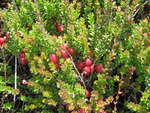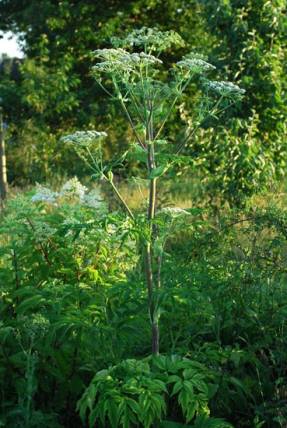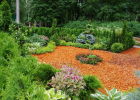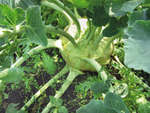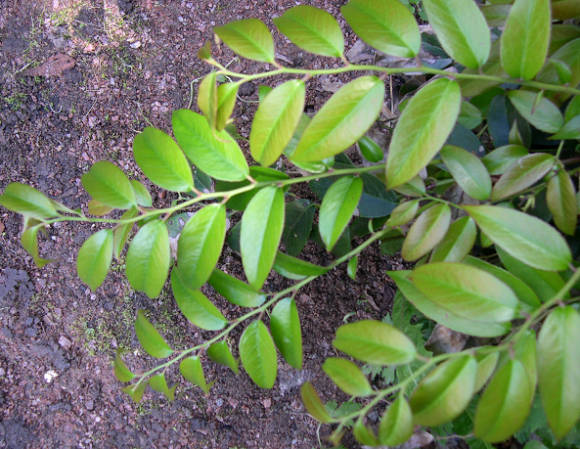The medicinal raw materials of clary sage are inflorescences, which are cut and dried in the shade in a well-ventilated area.
Essential oil
 |
Cut inflorescences in the industry are immediately sent for processing. An industrial yield of 0.12-0.15% essential oil is considered quite satisfactory. In the leaves and stems, its content is 8-10 times lower than in the inflorescences.
Essential oil Clary sage is obtained in two ways: by steam distillation and extraction with petroleum ether or other volatile solvents. The essential oil obtained by distillation is a colorless or slightly yellowish-greenish liquid with a specific bergamot aroma. The specific gravity is 0.908-0.923. The resin of the essential oil contains up to 15% of sclareol, which has valuable odor fixing properties.
Extract oil (concrete) differs in a high content of sclareol (up to 45%) and is used for the manufacture of a wide range of persistent fragrances. Sclareol is used to obtain synthetic substances with an amber aroma. It is interesting that from budding to the beginning of seed formation, its content in the inflorescences increases.
The main components of the essential oil: linalyl acetate (45-87%), geranyl acetate (0.3-3.2%), in small amounts neryl acetate and bornyl acetate. A significant part is made up of monoterpene alcohols - linalool (9-28.5%), geraniol (0.1-3.2%), nerol, traces of citronellol, terpineol. Monoterpenes α- and β-pinene, camphene, β-myrcene, cis- and trans-ocymene, limonene are present in small amounts. The sesquiterpenes and their derivatives present in the essential oil (germacrene D (3-5%), β-caryophyllene (1-3%), as well as α-copaen, β-elemene, β-bourbonene, δ-cadinene) are important for the pharmacological action. , α-humulene, β-eudesmol and α-bisabolol) and oxides (1,8-cineolkaryophylene oxide).
Clary sage seeds contain a fatty oil (25-30%) of light yellow color with a pleasant smell, which has high technical properties: it can be used in ceramic and porcelain production and for the manufacture of top quality drying oils.
Medicinal properties
 |
Since ancient times, clary sage has been used for eye inflammation and inflammatory diseases of the female genital area. It is a cult plant of the Celts, who have perfumed drinks for them. Such drinks helped the priests enter a trance during religious rituals.
Botanist N. Culpeper considered it to be a good relaxing and sedative agent. An infusion was made from the seeds, which was applied to sore eyes. Most likely, the effect was exerted by mucous substances that relieved inflammation and irritation. I. Bock in his 1577 herbalist recommends it as a means of increasing female fertility and as an aphrodisiac for cold women. As modern studies have shown, in its structure, sclareol is similar to female sex hormones - estrogens and therefore exhibits a similar effect in the body. It is used in the initial phases of the climacteric period to eliminate hormonal deficiency and emotional disorders, as well as in premenstrual syndrome.
Sage essential oil possesses antibacterial activity, high wound-healing ability and is equal in effectiveness to Vishnevsky's ointment. Oil is used to successfully treat burns and long-term healing ulcers, stomatitis and gingivitis. Sage concentrate obtained after processing raw materials is used to treat chronic diseases of the musculoskeletal system and peripheral nervous system (sciatica, sciatica). Dry inflorescences of the plant are added to the medicinal fees.In folk medicine, they are used against headaches, as a sedative for dysfunctions in women, and externally as a cosmetic.
Sage preparations, including oil, have a certain venotonic effect, and it is advisable to include them in collections and mixtures for hemorrhoids, varicose veins and circulatory disorders.
Outwardly, for skin diseases, it is used in the form of massage oil or ointment. Indications are acne, pustular diseases, dandruff, hair loss, oily skin of the face and scalp.
Inflorescence inflorescence prepare from 1 tablespoon of raw materials and a glass of boiling water, insist until cooled and take 1/3 cup. However, it is more often used in collections with other plants - cuff leaf, verbena, rosemary and others. For external use, the infusion can be prepared more concentrated - from 2 tablespoons of raw materials and a glass of boiling water. The resulting infusion is used to wipe problem skin, rubbed into the scalp for oily hair.
In the tobacco industry, sage is used to flavor expensive tobacco, and in the food industry - to flavor cheeses and tea. Clary sage essential oil is used in confectionery production.
Aromatherapy Applications
Clary sage is becoming quite popular in aromatherapy. There are reports of virucidal activity of essential oil against ortho- and paramyxoviruses, in particular influenza A and B. Effective use in the form of inhalation. The oil is applied to a pillow, wrist joint, or an aroma lamp is used. It has a relaxing, antispasmodic effect. May improve mood for seasonal depression, chronic fatigue, nervousness, stress, anxiety and fear. Antioxidant, hypotensive and choleretic effect is noted. The sage scent can relieve migraines and headaches in women if they are associated with hormonal problems.
The oil goes well with the oils of bergamot, cardamom, cistus, grapefruit, jasmine, coriander, lavender, pink geranium, sandalwood, juniper, incense and especially rose.
Contraindications
Oncological diseases, mastopathy. It is not recommended to use during pregnancy and simultaneously with the use of alcoholic beverages, it is believed that it enhances their effect. In addition, sage essential oil causes relaxation and low concentration, which is undesirable when driving.
About the agricultural technology of clary sage - in the article Growing clary sage in the middle lane.
Photo by Rita Brilliantova and from the GreenInfo.ru forum

